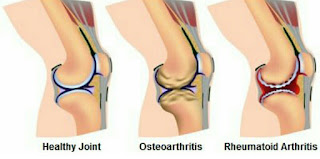Arthritis is a common disease but not well understood. It is a joint disease featuring inflammation on one or more joints, it is related to people of all ages, sexes and races but occurs more as people grow older. There are over 100 types of arthritis and the primary symptoms are pain, swelling in and around the joints, warmth, redness of the overlying skin, stiffness, deformity and diminished range of joint motion.
Arthritis have the tendency to affect the joints, muscles, ligaments, cartilage, and tendons and also have the potential to affect some internal organs and can be life threatening, it can cause irreversible damage to the joints if left untreated, arthritis affects the body's movables such as, joints at the knees, wrist, elbows, fingers, toes, hips and shoulders.
- When a single joint is involved it is called mono-arthritis
- When 2 or 3 joints are involved it is called oligo-arthritis
- When 4 or more joints are involved it is called poly-arthritis
- Pain
- Gland swelling
- Fatigue
- Weight loss
- Fever
- Limited function of joints
- Chronic inflammation of joints
- Feeling unwell
- Symptoms from abnormalities of organs like; lungs, heart, eyes and kidneys
Causes
This depend on the form of arthritis
- Osteoarthritis - injury
- Gout - metabolic abnormalities
- Infection - bacteria and viral diseases
- Misdirected immune system - autoimmunity disorder
Arthritis of weight bearing joints can keep you from walking comfortably or sitting up right, in some cases joints may become twisted and deformed.
Risk factor
- Excess weight
- Family history
- Injury
- Age
It can be prevented by staying active, maintaining a healthy weight and avoiding injury.
- When large joints such as the knee joint is affected, there can be loss of cartilage with limitation of motion from the damaged joints
- When small joints such as the fingers are affected, there can be bone growth and loss of hand grip and strength of the hand.
The two most common types of arthritis are osteoarthritis and rheumatoid arthritis, they damaged joints in different ways.
Osteoarthritis
The most common form of arthritis is osteoarthritis. It happens when the cushioning surface of the end of bones wear away causing bone to rub against bone, leading to pain swelling and stiffness. this is a common degenerative joint disease that affects the cartilage, joints lining, ligament and and underlying bone of a joint, it is caused by a reduction in the normal amount of cartilage tissues through wear and tear throughout life. The breakdown of these tissues eventually lead to pain and joint stiffness, the joints mostly affected by osteoarthritis are those that are heavily use such as hips, knees, hands, spine, thumb and big two joint.
Rheumatoid arthritis
This occurs when the body's inner system attacks the tissues of the body, mainly connective tissues, leading to joint inflammation, pain and degeneration of the joint tissues, it affects joints systematically on both sides equally, it may initially begin in a couple of joints only and most frequently attack the wrists, hands, elbows, shoulders, knees and ankles.
Do not overlook these rheumatoid arthritis symptoms
Do not overlook these rheumatoid arthritis symptoms
- Tingling and numbness
- Breathing issues
- Abnormal spot on finger tips
- Infection
- Bruising
- Bone fracture
- Dry eyes
Rheumatoid arthritis can go beyond swollen joints. Because many of the arthritis are rheumatic diseases, it can affect various organs of the body that do not directly involve the joints.
Treatment
The treatment depends on which particular form of arthritis is present, its location, severity, persistence and any underlying background and medical condition of the individual, each treatment program must be customized for individual patient, some treatment programs involves weight reduction and avoiding activities that exert stress on the joints.
- Dietary change is important
- Water - helps lubricate the joints
- Calcium rich food - for bone regeneration
- Fish - rich in anti inflammatory properties
- Garlic and Ginger - powerful antioxidant with anti inflammatory effects
- Cayenne pepper - contains a compound called capsaicin that relieve pain
- Turmeric - reduce pain and inflammation
- Massage and light exercise - improve bone function
- Acupuncture - best treatment for arthritis
- Reduce pain and inflammation
- Prevent further damage
- Strengthen the bones
- Repair damage joint tissues
- Eradicate the symptoms
Caution
- Check for possible food allergies, it triggers inflammation
- Do not use iron supplement in your cause of treatment, it is suspected to be involved in pain and swelling
- Reduce fat and oil intake and avoid fries
- Avoid caffeine, alcohol, citrus fruits, meat, salt, monosodium glutamate and all sugary products.
- Avoid cold food and water






























